AMD Radeon HD 7750 & Radeon HD 7770 GHz Edition Review: Evading The Price/Performance Curve
by Ryan Smith & Ganesh T S on February 15, 2012 12:01 AM EST- Posted in
- GPUs
- AMD
- HTPC
- GCN
- Radeon HD 7000
Power, Temperature, & Noise
As always, we wrap up our look at a new video card with a look at the physical performance attributes: power consumption, temperatures, and noise.
While it’s the second sub-series of the 7000 series, the 7700 series is actually first in a number of ways for AMD. It’s the first midrange series to feature PowerTune since its introduction in 2010, and it’s the first time the 28nm process has been used on such low power cards. As such the power, temperature, and noise characteristics of the 7700 series are virtually a blank slate waiting to be filled.
| Radeon HD 7700 Series Voltages | ||||
| Ref 7750 Load | Ref 7770 Load | XFX R7770 BESDD | ||
| 1.1v | 1.2v | 1.2v | ||
The idle voltage for all 3 of our 7700 series cards was 0.825v. Meanwhile the load voltage for our 7750 was 1.1v, while it was 1.2v for both the reference 7770 and the XFX BESDD.
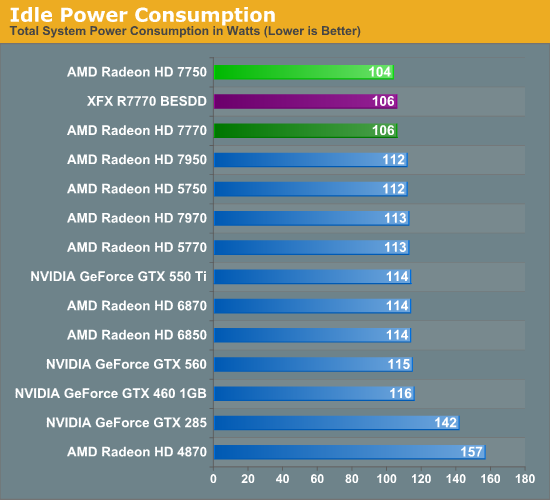
AMD’s official idle power consumption figure is <10W for both the 7750 and 7750. In practice we find that there’s a 2W difference between the two cards, with the 7750 coming in at 104W at the wall and the 7770 at 106W. AMD’s continuing efforts to reduce idle power consumption are clearly paying off, making this the lowest idle power usage figures we’ve recorded yet.
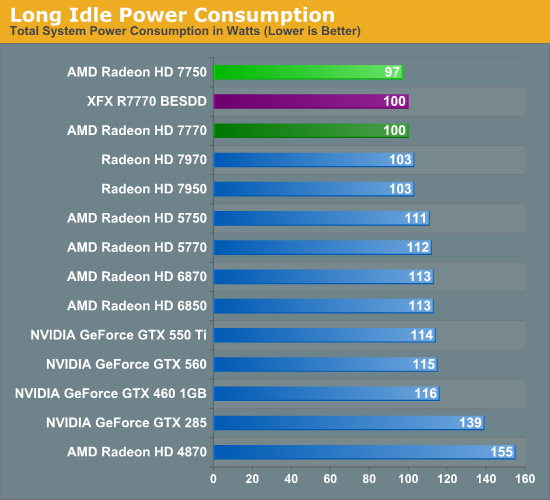
Meanwhile under the so-called “long idle” scenario with a blank monitor, the 7000 series continues to cement its lead. Officially all Southern Islands cards have a long idle power consumption level of <3W since they should all be using the same PCIe controller to keep a heartbeat going, however we’re finding there is a difference, even between the 7750 and 7770. The 7770 consumes 3W less than the 7900 series, meanwhile the 7750W consumes another 3W less, bringing it down to 97W. Since our readings are from the wall it’s tough to gage just how much these cards are still using, but at this point there doesn’t seem to be much farther to drop.
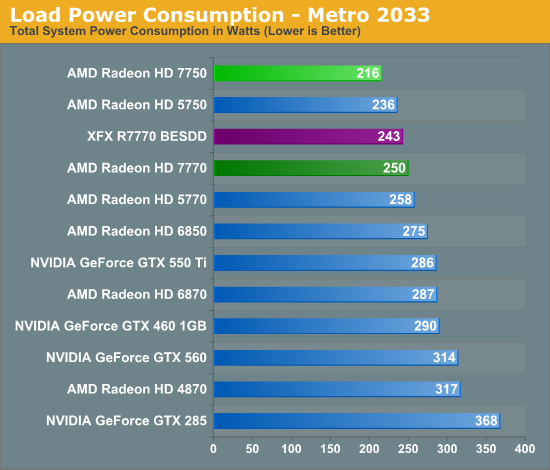
When we talk about the 7700 series bluring the line between what we’d expect out of an AMD 700 series card and an AMD 600 series card, results like this are part of the reason why. With a 75W PowerTune limit the 7750 has the lowest power consumption of any of the cards in our lineup, beating even the 5750. The 7750 is clearly in a league of its own, with only the 7770 drawing similar amounts of power as the 5700 series.
To that extent, it’s interesting to note that the XFX BESDD consumes less power than the reference 7770, in spite of its factory overclock. XFX did not increase the voltage of the card, but we’d still expect power consumption to go up at least a bit, not come down. In any case even with its 10% better performance, it’s consuming 7W less than the reference 7770 here. Otherwise at 250W the 7770 is pulling 8W less than the 5770 and 25W less than the 6850 from the wall, succinctly showcasing the power benefits of TSMC’s 28nm process.
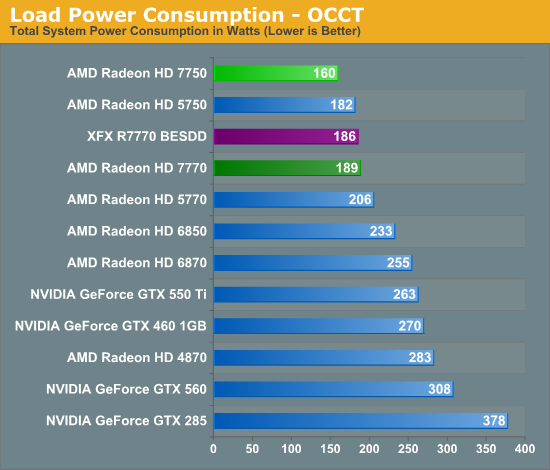
Our results with OCCT largely mirror Metro, with the 7750 in a class of its own while the 7770 consumes less power than anything other than the 5750. Since this is our pathological test, the lack of PowerTune plays a big part here, as PowerTune keeps the 7770 capped at 100W while the 5770 and 6850 are free to go well over their TDPs.
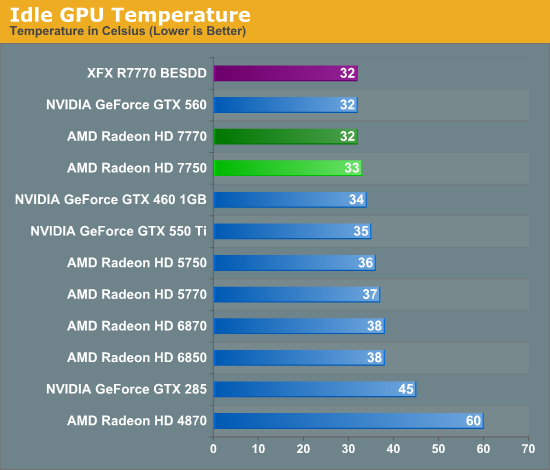
There’s little to say about idle temperatures that hasn’t been said before. With a half-decent cooler, almost any card can reach the mid-to-low 30s. The 7700 series is no exception.
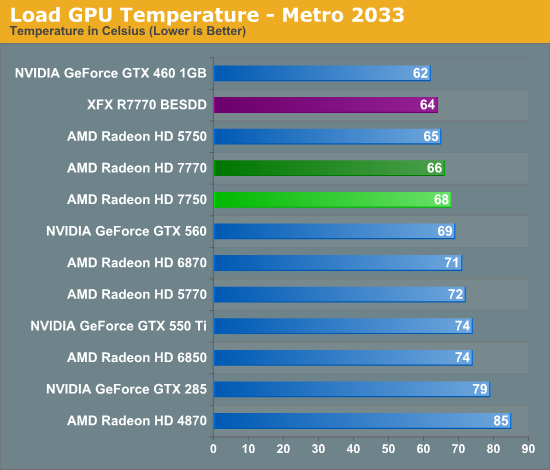
Moving on to Metro, our results are largely consistent with what we’d expect given our earlier power data. Even with the lower power consumption of the 7700 series AMD can’t quite beat the GTX 460 1GB, otherwise with temperatures in the mid to upper 60s the 7700 series looks quite good. XFX’s BESDD looks especially good thanks to the fact that it’s an open air cooler, as it only reaches 64C.

As with OCCT power consumption, OCCT temperatures are largely a story of PowerTune or the lack thereof. With PowerTune clamping down on power consumption, temperatures never rise by too much. At 71C the reference 7770 is still doing well, while XFX’s card does even better.
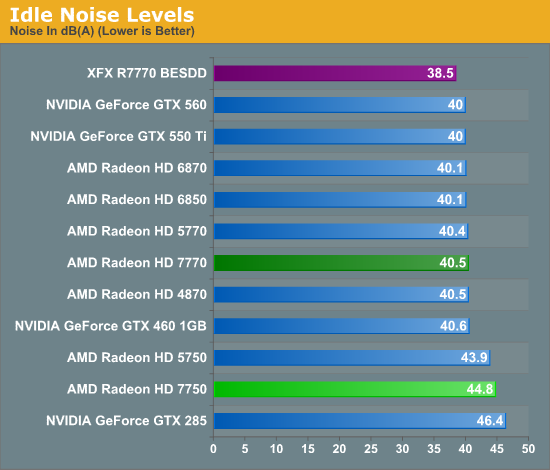
Based on our power and temperature data, our noise data came at somewhat of a disappointment. The 7750 has a small fan with an idle fanspeed of 39%, leading to it being quite loud relative to its competitors. Thankfully none of AMD’s partners will be using that specific cooler, so we wouldn’t expect any retail cards to be this bad. Though if silence is key, Sapphire’s passively cooled 7750 is always an option.
As for our 7770 cards there aren’t any surprises. The open air cooled XFX BESDD does the best, though at only 40.5dB the reference 7770 is doing almost as well on its own.
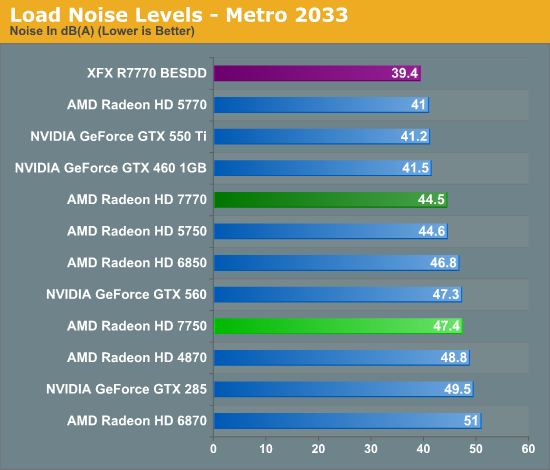
I had to rerun Metro a few times just to make sure our XFX BESDD numbers are right; and they were. XFX’s open air cooler combined with the 100W board limit of the 7770 means that there’s relatively little heat to dissipate, which the open air cooler does extremely well. While this isn’t technically silent it’s damn close.
Elsewhere the reference 7770 does decently, but its half blower nature hurts it when it comes to noise. The noisy 7750 only gets louder, unfortunately.
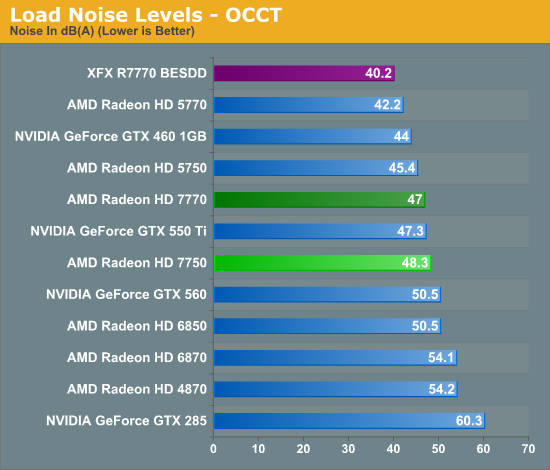
Finally, noise under OCCT is nearly the same story. The XFX BESDD finally goes above 40dB, a testament to the capabilities of XFX’s open air cooler. As for the AMD cards, there’s really not a great deal positive to say as even a traditional blower shouldn’t be quite as bad as what we’re seeing with the reference 7770. Perhaps it’s for the best that none of AMD’s partners are using their reference designs.










155 Comments
View All Comments
kallogan - Wednesday, February 15, 2012 - link
HD 6850 is still the way to go.zepi - Wednesday, February 15, 2012 - link
So basically in couple of generations we've gone4870 > 5770/6770 > 7770
Chip size
260mm2 > 165mm2 > ~120mm2 chip.
Performance is about
100 > 100 > 120
Power consumption in gaming load according to Techpowerup (just graphics card):
150W - 108W - 83W
And soon we should have 1 inch thick laptops with these things inside. I'm not complaining.
silverblue - Wednesday, February 15, 2012 - link
Good point. One thing I think people forget is that smaller processing technologies will yield either better performance at the same power, or reduced consumption at the same performance... or a mix of the two. You could throw two cards in dual-GPU config for similar power to one you had two years back, and still not have to worry too much if CrossFire or SLi doesn't work properly (well, if you forget the microstuttering, of course).cactusdog - Wednesday, February 15, 2012 - link
WHy is the 6770 left out of benchmarks?? Isnt that odd considering the 7770 replaces the 6770? I really wish reviewers would be independant when reviewing cards, instead of following manufacturer guidelines.Markstar - Wednesday, February 15, 2012 - link
No, since the 6770 is EXACTLY the same card as the 5770 (just relabeled). So it makes sense to continue using the 5770 and remind AMD (and us) that we do not fall for their shenanigans (sadly, many do fall for it).gnorgel - Wednesday, February 15, 2012 - link
For your 6850. It should sell a lot better now. Maybe they really stopped producing it and need to get rid of stocks. But when it's sold out almost anyone should go for a gtx 560, 7% more expensive and 30% faster.The only reason to buy a 7770 now is if your powersupply can't support it and you would have to get a new one.
duploxxx - Wednesday, February 15, 2012 - link
by the time the 6850 is out of stock the 78xx series are launched which will knock out 560don't understand what evryone is complaining about, its faster then the 57xx-67xx series, les spower. sure it's not cheap but neither are the 57-67 @ launch. Combined with old gen available and NV products a bit to expensive but this is just starting price....
akbo - Wednesday, February 15, 2012 - link
Moore's law apparently doesn't apply to graphic cards. People expectations do. People expect that every two years gpus at the same price point have double transistors and thus be faster by so. Obviously perf does not scale like so since the 28 nm shrink only has a 50% improvement from 40 nm. However that would mean a 50% improvement is expected. Imperfect scaling would mean a 40% improvement.So people expect that a card which is 20% faster than a card from 2 years ago to be 1.2/1.4 the price at launch, or an ~ 85% of the 5770 launch price in this case. That would mean that the card should retail at around $130-140 or so for the 7750 and sub-$100 pricing, like $90 or so. I expect it to be that price too.
chizow - Wednesday, February 15, 2012 - link
Moore's Law does actually hold true for GPUs in the direct context of the original law as you stated, roughly doubled transistors every 2 years with a new process node. The performance has deviated however for some time now with imperfect scaling relative to transistors, but at least ~50% has been the benchmark for performance improvements over previous generations.Tahiti and the rest of Southern Islands itself isn't that much of a disappointment relative to Moore's Law, because it does offer 40-50% improvement over AMD's previous flagship GPU. The problem is, it only offers 15-25% improvement over the overall last-gen performance leader the GTX 580 but somewhat comically, AMD wants to price it in that light.
So we end up with this situation, the worst price performance metrics ever where a new GPU architecture and process node only offers 15-25% performance increase at the same price (actually 10% more in the 7970 case). This falls far short of the expectations of even low-end Moore's Law observer estimates that would expect to see at least +50% over the last-gen overall high-end in order to command that top pricing spot.
arjuna1 - Wednesday, February 15, 2012 - link
DX11.1?? With only one true DX11 game on the market, BF3, there is literally no incentive to upgrade to this generation of cards 7xxx/kepler.Unless nvidia comes out with something big, and I mean big as in out of this world, I'll just skip to the next gen, and if AMD insists in being an ass with pricing, I'll go Ngreen when the time comes.
Now, the worrying thing is that it's becoming evident, both parties are becoming too cynical with price fixing, when is that anti trust lawsuit coming?